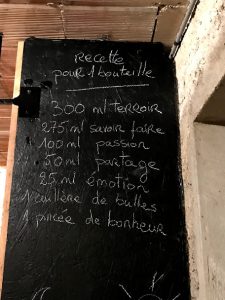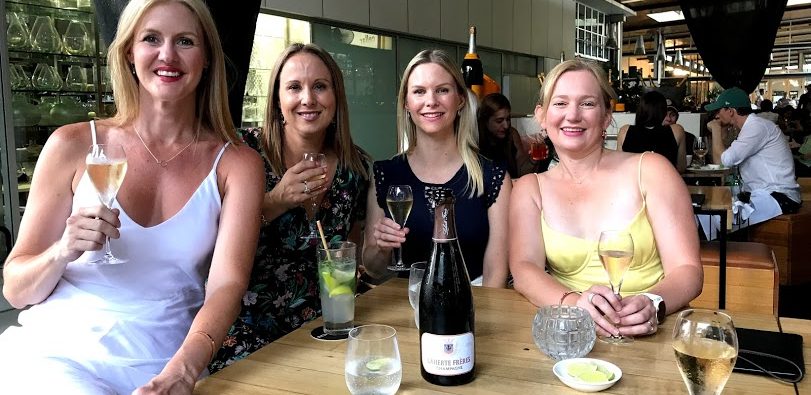
Top 5 Grower Champagne Producers I Met In 2018
- Marnie Nichols
- December 14, 2018
- Blog, Grower Champagnes, Top Fives
In June and July 2018, I spent 5 weeks in Champagne (the place!) and visited 53 champagne producers and enjoyed many more tastings in dozens of tasting bars and restaurants.
It is impossible to narrow my experience down to one single “top 5” and give due credit to all the amazing, kind, generous, fun, and friendly people I met in Champagne. And while visiting 53 champagne producers might sound like a lot, there are actually 4,701 different champagne producers. In Australia, we only get 247 of them to try.
So I am writing a bunch of different top 5s in various categories from my visits, starting with the top 5 grower champagne producers I met. Not all of these champagnes are available in Australia, but I really wanted to introduce some of the small, family producers you would never have heard of. In case you ever visit Champagne you can seek out their champagnes.
So here goes…
The top 5 grower champagne producers I met in 2018
So these are all growers (which means they make champagne from just their own grapes… read more here) and I actually met the winemaker in person for a tasting and interview.
Champagne R. Pouillon & fils
Mareuil-sur-Aÿ (Vallée de la Marne)
I have featured Champagne R. Pouillon & fils champagnes before in my top man champs and champagnes for a really special occasion.
Champagne R. Pouillon & fils is based in Mareuil-sur-Aÿ, a small village about 10 minutes from Epernay (one of the two biggest towns in the region). Other champagne houses you may know that are based in the same village are Billecart-Salmon and Philipponnat.
I met with the winemaker, Fabrice Pouillon. Fabrice has been working in the vineyards and making champagne for 20 years. His grandfather started making champagne in 1947 after a long family history of growing grapes to sell to the big houses. There are just over 50,000 bottles of Champagne R. Pouillon & fils produced a year, and in Australia we are lucky to get a really small allocation of his wines.
I started my tour with Fabrice jumping in his truck and driving up to the vineyards to look at his vines. An awkward moment when I tried to get in the driver’s side… I still hadn’t quite adapted to left hand drive!
The vines were a good place to start our visit as the first thing Fabrice explained to me was that he needs the best quality grapes to make high quality champagne so his primary focus is on the grapes while they are on the vines. Because he is a grower producer (RM) and he can only use his own grapes to make his wines, and he knows exactly where his grapes come from and exactly how to let that origin be expressed in the champagne.
Fabrice Pouillon from Champagne R. Pouillon & fils showing me the champagne region from the outlook near his vineyards in Mareuil-sur-Aÿ (Vallée de la Marne)
Champagne R. Pouillon isn’t a certified biodynamic and organic grower but Fabrice uses only minimal chemicals. He passionately prefers biodynamic and organic options unless his vines are seriously threatened, then he will resort to non-organic techniques. This is actually quite a common philosophy and is completely understandable remembering growers can only use their own grapes – so if they lose their grapes, they lose their champagne.
We get small allocations of his wines in Australia… you will find the best selection at Emporer Champange.


Nicolas Maillart
Ecueil (Montagne de Reims)
Nicolas Maillart is another grower champagne producer and his family history of vine-growing dates back to 1753! That makes Nicolas a 9th generation winemaker, he has been the winemaker at Champagne Nicolas Maillart since 2003.
Based in Ecueil in the Montagne de Reims, the cellars are about 20 minutes from Reims, the largest city in Champagne. Nicolas’ vines are all located in premier and grand cru villages in the Montagne de Reims, so it follows that 75% of his vines are pinot noir.
The best word I can think of to describe Nicolas’ wines is balanced. He talked about balance a lot in our chat and it’s bang on. He uses a variety of blends, vintages, and vineyards across his range as well as varying dosage, but it’s never about following a trend for low dosage champagnes… he uses the dosage that the wine needs. We tried about 5 different wines and I’ve since found his entry level Platine Extra Brut Premier Cru in Australia. It’s pinot noir dominant but surprisingly fresh, and 3g/l making it easy to drink, and the perfect teaser for the rest of his champagnes which just get more interesting and expressive.
I actually visited Nicolas on my last day in Champagne and his chalkboard recipe for a bottle of champagne (below) is one of the things that stuck with me most from my whole trip. It sums up the small, grower approach to winemaking and also captures the spirit of family and a personal touch that I am sure makes his champagnes taste better.

Roughly translated, every bottle of champagne is part terroir, part know-how, part passion, part sharing, part emotion, part bubbles, part happiness.

Jean Vesselle
Bouzy (Montagne de Reims)
I was introduced to Champagne Jean Vesselle by my tour guide, Brice, from The Champagne Tour Company.
I had specifically asked for visits in Bouzy on my day with Brice because I love high pinot noir champagne and some of my fave champagnes contain grapes from the Grand Cru village of Bouzy. There is a very traditional but unique terroir in Bouzy that I just love. Apparently, this can be put down to Bouzy being one of the warmest areas, and the slopes lie just far enough from the Marne to be more mountain than valley and are south facing, so they get plenty of sun which produces ripe, full-bodied wines. Bouzy is also very well known for making the still red wine that is used in the best rosé champagnes.
There are many champagne producers with Vesselle in the name in Bouzy, but Delphine (whose father was Jean) from Jean Vesselle is the name to seek out. I had an amazing chat with Delphine who is driven, dynamic and passionate about the 145,000 bottles a year she produces.
On my visit, I was very lucky to taste a selection of their wines with Delphine, including the one which stole my heart, Le Petit Clos. If you know my champagne style – which you might if you’ve been following me for a while – this one ticks ALL my hot spot boxes… 100% pinot noir, 3/4 g/l, barrel aged. Insane and exceptional.
Jean Vesselle is also well known for its Oeil de Perdrix which is a champagne style which sits between the usual gold coloured champagne and rosé champagne. It gets its very subtle colour from the pressing. They are so well known for it, they were out of stock when I visited, so I promised Delphine I’d be back to try it.
Sadly Jean Vesselle isn’t exported to Australia 

Champagne Egrot
Aÿ (Vallée de la Marne)
One of the smallest and newest champagne producers I met, Elizabeth started Champagne Egrot with her husband Jean-Marie in 2012.

I met with Elizabeth who grew up in Champagne and worked in her family house, Champagne H. Goutorbe, learning the art of winemaking. But when her father passed away, her brother (who had worked away from the family business) returned to take over the family business. Elizabeth had learned so much and loved making wine, so decided not to waste her talents and started her own house.
Her favourite parts of running her own champagne brand are first doing the blending and then watching people enjoy her champagnes, and seeing them come back.
They only produce between 5,000 and 10,000 bottles per year and currently only make three champagnes – a Brut, Extra Brut (2/3 pinot noir, 1/3 chardonnay and 2g/l) and Vintage 2009 (2/3 pinot noir, 1/3 chardonnay and 0g/l and 100% Ay Grand Cru grapes). While 2008 was the first vintage they made, the 2009 is the first vintage they have released, and Elizabeth said they are likely to release the 2011 before the 2008. I felt pretty lucky to have tried their first vintage release and promised to come back and taste the 2011 and 2008 when they are ready!
Outside Europe, Champagne Ergot is distributed in California and Denmark… not in Australia yet, but I wanted to write about Elizabeth and her wines as an example of a very small, very new producer.


Champagne De Sousa
Avize (Côte des Blancs)
I met Charlotte De Sousa at her family winery in Avize in late June, 2018.
Avize is in the heart of the Côte des Blancs area of Champagne, the homeland for chalky, fresh, crisp, chardonnay dominant champagnes. A complete change of style from the first four growers I talked about.
It is true my preferred champagne style is pinot noir so for my 2018 trip, I did focus more on the northern areas of Champagne, the Montagne de Reims. I visited at least 5 producers in Côte des Blancs, but I will focus more here next time.
The chalk in the soil in and around Avize runs deep… and the roots of the De Sousa vines grow 40 metres down into the chalk, imparting a minerality and clarity to the wines that I immediately fell in love with. A small producer, the family makes about 85,000 bottles of champagne a year and it is one of a tiny number of certified biodynamic champagne producers in the entire region. I’ll write more about biodynamic champagnes… it’s an interesting topic that cynics might say is more about marketing than wine making. But when I asked Charlotte why they chose to become biodynamic, the answer was so honest, authentic and passionate, I have no doubt about her philosophy.



I have tried (and loved!) all of the wines in the De Sousa range (with the exception of a vintage), and I’ve raved about the Brut Rosé in my Top 5 Spring Rosés, and I walked away from my visit with Charlotte with three new fave blanc de blancs.
In Australia, you can get your hands on most of the De Sousa champagnes from Emperor Champagne. Emperor currently stocks the Grand Cru Reserve, the Mycorhizes Grand Cru, the Brut Rosé as well as the 3A (Aÿ, Ambonnay & Avize) and their entry level NV Brut Tradition.
Read more about my visit and tasting with Charlotte De Sousa here.
My interview and tasting with Charlotte De Sousa, Champagne De Sousa
And that’s a wrap on the top 5 grower champagne producers I met this year.
Santé
Marnie
xx
As always I want to know what grower champagne producers you’ve tried and what you like! Post a pic and tag @bubbleandflute or #bubbleandflute #happychamper
Laherte Frères Ultradition NV
Grower Champagnes… Just Hype Or Seriously Hot?
Bubble & Flute promotes the responsible consumption of alcohol for individuals of legal drinking age in their country.











